
Features
Production
Research
Growers treated to strawberry field day
September 25, 2009 By Hugh McElhone
Strawberry trials are well underway at the Cedar Springs Research Station, just west of Blenheim, Ont., and growers were recently invited to a strawberry and plasticulture field day.
Strawberry trials are well underway at the Cedar Springs Research Station, just west of Blenheim, Ont., and growers were recently invited to a strawberry and plasticulture field day.
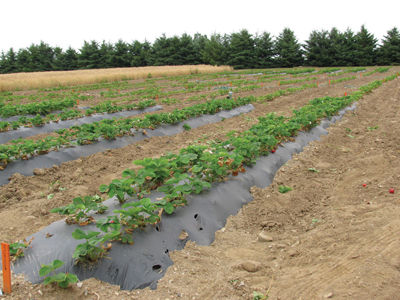 |
| In plastic mulch trials, total fruit yield per plant is recorded as well as soil temperature under the different coloured mulches. (Photos by Hugh McElhone) Advertisement
|
The test subjects included Seascape and Albion strawberry cultivars, which are being assessed on how they respond to planting density, blossom removal time and different coloured plastic mulches, to name just a few. Breeding of day neutral hybrids is also being conducted. These trials take place in the open field, as well as in a Haygrove tunnel.
The timing of blossom removal on berry weights and yields does appear to have an impact, says John Zandstra, research horticulturalist with the University of Guelph. Blossoms were removed at four, six and eight weeks after transplanting in 2008, the first year of picking.
Of the two cultivars assessed, Seascape’s marketable yield was highest at 2.89 kg per plot when the blossoms were removed at week four, versus 2.64 kg at week eight. A berry weight of 15.7 grams, however, was obtained when blossoms were removed at week eight, versus 14.8 grams at week four.
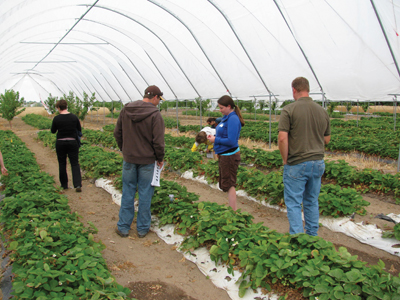 |
|
| Participants tour the University of Guelph’s strawberry breeding and research trials at a special open house held earlier this summer. |
|
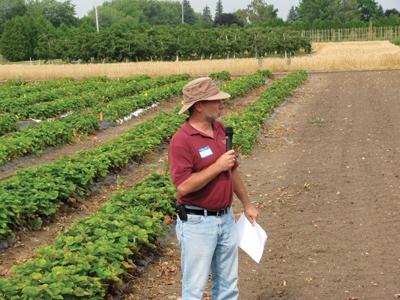 |
|
| John Zandstra, a research horticulturalist with the University of Guelph, explains his trial involving the timing of blossom removal on berry weights and yields. |
|
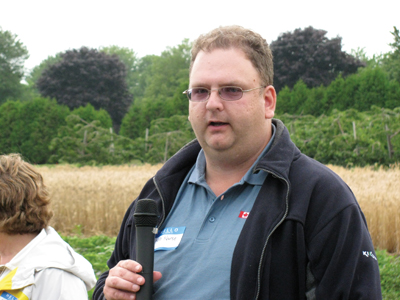 |
|
| The best way to keep the weeds down beneath the plastic and between the mulch rows is being studied by Rob Nurse with Agriculture and Agri-Food Canada (AAFC). |
|
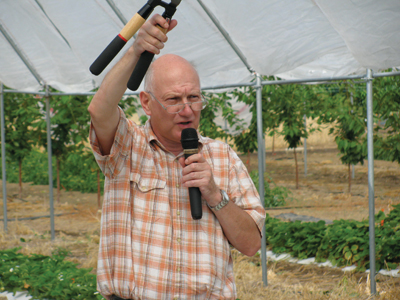 |
|
| University of Guelph plant breeder Dr. Adam Dale brandishes a pair of hedge clippers, his tool of choice when eliminating strawberry seedlings from his breeding stock. |
Albion was the opposite of Seascape and consistently performed better with later blossom removal. The highest marketable weight of 1.82 kg per plot occurred with removal at week eight versus 1.57 kg at week four. Average berry weight for week four was 15.7 grams but increased to 16.4 grams when blossoms were removed in both weeks four and eight.
“There really wasn’t a big difference last year,” says Zandstra. He added researchers plan to wait for the completion of the 2009 data to see if the trend is consistent for both cultivars.
Despite the current trial results, the researchers tend to agree that the plant should determine when it is the best time to remove blossoms. Rather than following a strict calendar program, Zandstra suggests blossoms be removed when the plant is at the three- to four-leaf stage, regardless of what week that occurs in.
In the plastic mulch trial, the total fruit yield per plant was recorded as well as the soil temperature under mulches of various colours. At the Cedar Springs site, the silver/black mulch performed the best for fruit yield and berry weight, followed by the white/black. “The silver/black was a bit cooler and produced 70 per cent marketable weight,” Zandstra said.
The same mulches were compared at the cooler New Liskeard site. According to University of Guelph researcher Becky Hughes, who is based at the site, the brown mulch produced the highest yield per plant, followed by black/white.
Zandstra explains that as the temperature rises, production declines, so finding the best mulch for your growing area is important. “Anything you can do to keep them cool is good. They don’t like heat and by 35 degrees (Celsius), they’re done,” he added.
The best way to keep the weeds down beneath the plastic and between the mulch rows is being studied by Rob Nurse with Agriculture and Agri-Food Canada (AAFC). Nurse notes that some visual injury did occur to strawberry leaves with some products but overall weed control was excellent.
Nurse is also testing some non-herbicide weed control options, such as filling the row middle with a two-inch layer of compost. In another treatment, a layer of newspaper was put down followed by a two-inch layer of compost, which achieved 100 per cent control. Fall rye sown in the spring was also evaluated. “Rye is good. It’s the best as a living mulch,” he notes.
One of the problems in breeding day neutral strawberry hybrids has been in achieving consistent quality, says Dr. Adam Dale, a plant breeder with the University of Guelph. Along with quality, researchers are also looking for high yield, firmness and flavour.
Dr. Dale notes that the Ontario growing season generally runs from May to October while the Florida season is just starting up in October. “It’s nice that we’re not competing with them,” he says, adding that Florida hybrids are included in the breeding program with Canadian ones. “We get the seed, plant it in the greenhouse in February, and transplant it in the field in May.”
In order to get seed to develop, researchers physically take the pollen from one variety and brush it on another. Dr. Dale explains there are more than 100 ovules on each strawberry so cross pollination is generally not a problem. He adds that his research team has some 24,000 seedlings to evaluate.
To evaluate seedling plants in the field, Dr. Dale uses hedge clippers in his selection process. “If it doesn’t have any flowers, cut it out. Cut out the whole family. The ones with flowers, these are considered day neutral.”
The fruit that eventually results from these flowers is later tested for firmness and flavour. “It may be the nicest looking strawberry you’ve ever seen but if it’s soft, or if it tastes sour, cut it out,” he adds.
From a family of seedlings, two or three may stand out and be spared the clippers for another year. Dr. Dale explains that it could easily take two to three years of clipping before a viable variety emerges.
To help keep all the varieties healthy, Karla Jackson and Rob Danford of Weather Innovations Incorporated (WIN) – based in Ridgetown, Ont. – are working on a disease forecasting system for strawberries. A similar and relatively successful system has been devised for tomatoes and they hope the model can also be applied to strawberries.
To build their disease probability model, Jackson explains that they measure such factors as wind direction and speed, soil moisture and leaf wetness. These figures are put into the model and a disease probability number is generated.
To test their success, test plots are located in the field. “We look at 10 plants per site. If four out of 10 have disease, that’s our indicator of the disease level,” says Jackson.
Their model was used for the first time on June 30, and timed for the start of the spraying season. It is too early to test their accuracy just yet, says Jackson. “Despite the cool, wet season, there has been no significant disease so far.”
Print this page